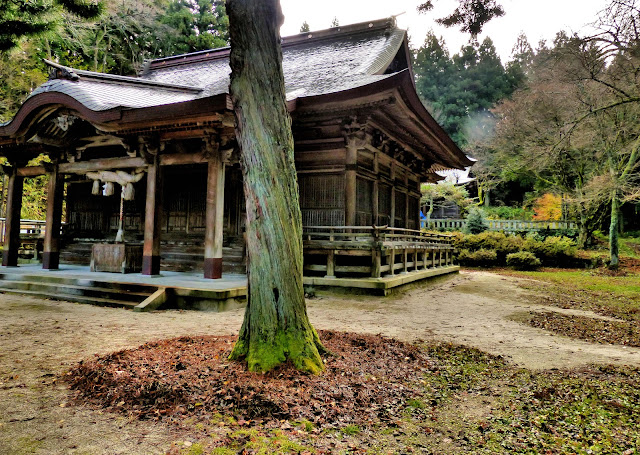Day 57 of my walk along the Kyushu pilgrimage was largely along the Nagasaki Kaido from saga City to Takeo Onsen. As usual, I tried to stop in at every shrine I passed in the hope of seeing something or learning something interesting. Usually, I would do an individual post for each shrine and do some research on the shrine history, stories behind the kami enshrined etc, but as these posts were never of much interest to many people from now on I will just post highlights. Noticeable in this first shrine is the Hizen style torii. Torii styles tend to be based on other factors than region, but Hizen is unique in this regard.
Offerings of sake and oranges are common at shrines and temples, with oranges being most popular after the new year. Though this was a shrine, the small altar was with a Buddhist statue, something that was outlawed in early Meiji but which is increasingly found nowadays.
Fukumohachimangu is quite a large shrine on a hilltop in Omachi. It became a Hachiman shrine in the 9th century but the earlier shrine is linked to stories of Yamato Takeru and his fight with the Kumaso tribe, one of the two big "tribes" of Kyushu that resisted Yamato control. A series of torii lead from the main road and then up the hill, but only one was in Hizen style.
What Fukumohachimangu had, that most shrines have, was a large sacred tree. In this case it was marked with a shimenawa rope, but many such trees do not have a shimenawa. One way of spotting a shrine from a distance is to see a grove of unusually large trees.....
Kaido shrine lies on the bank of Yaigome Pond, a large reservoir that feeds the rice paddies of the Saga Plain. The torii still retains an influence of Hizen style. Enshrined here are Toyotamahiko, Toyotamahime, and also others including Sugawara Michizane.
The final four photos all were taken at Inanushi Shrine, very close to
Fumyozan Koyaji Temple. According to one source, the Hizen style torii which is dismantled and lying next to the approach road was the first Hizen style torii in Saga on the Nagasaki Kaido coming from Nagasaki.
Horse statues in stone are quite rare. Modern ones in bronze or wooden ones undercover are far more common. It was here that I discovered the
unusual komainu statues.
There were several Inari shrines in the grounds, including this small stone one, and also tghis larger one housed in a small wooden hall.






























































